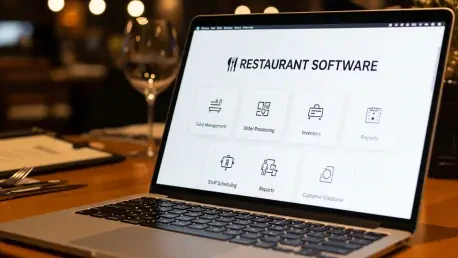Introduction to Restaurant Technology: A Digital Transformation
The hospitality industry stands at a pivotal moment where technology is no longer a luxury but a necessity for survival, and with guest expectations soaring, restaurants and bars are compelled to integrate digital tools to meet demands for speed, personalization, and seamless experiences. From mobile ordering apps to contactless payment systems, technology now underpins every facet of operations, transforming traditional service models into dynamic, tech-enhanced ecosystems. This shift reflects a broader digital transformation that reshapes how establishments connect with patrons and manage daily tasks.
This evolution is driven by a need to keep pace with consumer behaviors that prioritize convenience and efficiency. Restaurant owners face the challenge of balancing operational demands with innovative solutions, while software providers must develop tools that cater to these complex needs. The dual focus of this guide targets both stakeholders—offering insights for owners seeking practical systems and for SaaS providers aiming to build relevant, scalable platforms. Technology’s role extends beyond mere automation, becoming integral to kitchen workflows, customer interactions, and financial oversight.
The significance of this transformation cannot be overstated as it impacts everything from order accuracy to revenue tracking. Digital tools like kitchen display systems and real-time payment processing have become the backbone of modern hospitality, ensuring smoother operations during peak hours. As the industry continues to adapt, understanding the interplay between technology and service remains crucial for staying competitive in an ever-changing landscape.
Current Trends and Market Insights in Restaurant Tech
Key Trends Shaping the Industry
The restaurant technology sector is experiencing a profound shift toward cloud-based platforms, which offer scalability and cost-efficiency compared to traditional on-premise systems. These solutions enable businesses to update menus, track inventory, and manage staff remotely, reducing the burden of physical infrastructure. The flexibility of cloud systems also allows for seamless updates and integrations, making them a preferred choice for establishments of varying sizes.
Another prominent trend is the adoption of real-time dashboards that provide instant operational insights. Managers can monitor sales, adjust staffing, and tweak offerings on the fly, ensuring agility in high-pressure environments. This capability empowers decision-making with data that reflects current conditions, rather than relying on outdated reports or manual processes.
Additionally, automation is streamlining repetitive tasks such as order confirmations and marketing campaigns, freeing staff to focus on guest engagement. Unified customer data systems are also gaining traction, consolidating information across channels for a cohesive experience, whether a patron orders online or dines in. Lastly, the demand for open, modular systems is rising, as businesses seek to avoid vendor lock-in and customize solutions to their unique workflows, fostering greater control over their tech stack.
Guest Expectations and Market Dynamics
Guest expectations have evolved dramatically, with a clear preference for frictionless digital interactions that prioritize speed and ease. Whether scanning a QR code for a menu or paying via a mobile app, patrons expect intuitive processes that minimize wait times. Surveys from industry bodies like the National Restaurant Association indicate that over 60% of diners favor establishments with robust digital offerings, a trend that continues to shape operational priorities.
Personalization and omnichannel consistency further define consumer demands, as guests seek tailored experiences that remember past orders or preferences across platforms. Transparency in pricing and data usage also plays a critical role, with trust becoming a cornerstone of customer loyalty. Market projections suggest significant growth in hospitality tech adoption from 2025 to 2027, driven by the need for integrated systems that combine point-of-sale, inventory, and customer relationship management into a single framework.
These dynamics underscore a broader market shift toward technology that enhances rather than complicates the dining experience. As competition intensifies, establishments that fail to meet these expectations risk losing relevance. The focus on integrated, user-centric solutions signals a future where tech adoption is not just an option but a fundamental driver of success in the hospitality sector.
Challenges in Adopting and Developing Restaurant Software
The path to integrating technology in restaurants is fraught with obstacles, both technical and operational. One major hurdle is the fragmented hardware infrastructure many establishments rely on, where outdated point-of-sale terminals and mismatched kitchen displays struggle to communicate effectively. This incompatibility often leads to delays and errors, particularly during high-traffic periods, frustrating staff and guests alike.
Integration issues compound the problem, as diverse systems like payment gateways and loyalty programs frequently lack compatible APIs, hindering seamless data flow. Real-time performance demands add another layer of complexity, with systems needing to process orders and payments instantly under peak-hour strain. Multi-unit operations face additional challenges, balancing standardized reporting with localized menu or tax variations, often stretching software capabilities to their limits.
Beyond technical barriers, high staff turnover necessitates intuitive designs that require minimal training, while data silos prevent holistic insights into sales or customer behavior. Strategies to overcome these include adopting modular designs for flexibility, prioritizing API-first architectures for better integration, and focusing on system stability over extraneous features. Addressing these pain points is essential for both restaurant owners and developers to ensure technology serves as an enabler rather than a bottleneck.
Regulatory and Compliance Considerations in Hospitality Tech
Navigating the regulatory landscape is a critical aspect of deploying restaurant software, with compliance directly impacting operational legitimacy. Payment security standards like PCI DSS mandate stringent protocols for handling card transactions, while data privacy laws such as GDPR require transparent handling of guest information. These regulations demand robust safeguards to protect sensitive data and maintain customer trust.
Localized tax and labor laws further complicate the compliance picture, varying widely across regions and requiring adaptable software configurations. For bars, alcohol-specific regulations add layers of oversight, from age verification to inventory tracking, contrasting with broader food safety rules that dominate restaurant concerns. Integrating digital tools for tax reporting and audit trails can simplify adherence, ensuring records are accurate and accessible during inspections.
Partnering with third-party providers often proves effective in meeting these standards, as specialized vendors bring expertise in navigating complex legal frameworks. Software must be designed with compliance as a core feature, not an afterthought, to avoid costly penalties or operational disruptions. Staying ahead of regulatory changes remains a priority for developers and operators alike, ensuring technology aligns with legal obligations while supporting business goals.
Future Directions: Innovations and Opportunities in Restaurant Software
Looking ahead, the hospitality tech landscape brims with potential for innovation, driven by advancements like AI-powered menu pricing that adjusts based on demand or ingredient costs. Virtual assistants are emerging as tools for handling routine customer queries and reservations, enhancing efficiency without sacrificing the personal touch. These technologies promise to redefine how restaurants engage with patrons and optimize resources.
Demand forecasting represents another frontier, enabling precise staffing and inventory decisions through historical data analysis. Market disruptors like dynamic pricing platforms are also gaining ground, allowing venues to balance demand by adjusting rates during peak or slow periods. AI agents for fraud detection offer additional value, identifying anomalies in transactions or inventory before they escalate into significant issues.
Global economic conditions and a growing consumer preference for personalization will continue to shape these developments, pushing for sustainable and scalable solutions. The emphasis on tailored experiences suggests that software must evolve to anticipate individual needs while maintaining operational efficiency. As these innovations unfold, the opportunity to redefine hospitality through technology becomes increasingly tangible, offering a competitive edge to early adopters.
Conclusion: Navigating the Tech-Hospitality Fusion
Reflecting on the insights gathered, it becomes evident that technology has reshaped the hospitality industry into a more efficient and guest-focused domain. The integration of digital tools has proven transformative, streamlining operations and elevating customer experiences in ways previously unimaginable. Key trends like cloud adoption and automation have laid a strong foundation for scalability and responsiveness among restaurants and bars.
For restaurant owners, the actionable step is to prioritize user-friendly, adaptable systems that can grow with their business, ensuring minimal disruption during implementation. SaaS providers, on the other hand, find value in focusing on real-world usability and embedding compliance features from the outset, addressing practical challenges faced by operators. Both parties stand to benefit from investing in emerging areas like AI-driven insights and modular platforms, which promise to tackle evolving needs.
Looking forward, the fusion of tech and hospitality opens doors to unprecedented growth, provided stakeholders remain proactive in embracing innovation. Exploring partnerships and pilot programs for cutting-edge tools offers a pathway to stay competitive, while continuous feedback loops with end-users ensure solutions remain relevant. This journey, though complex, holds immense potential for those committed to bridging technology with the timeless art of hospitality.









